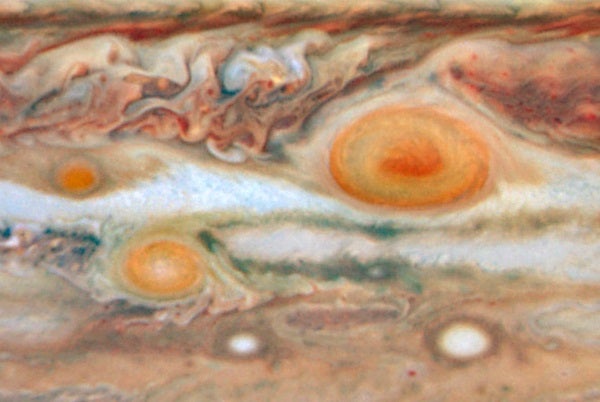In what’s beginning to look like a case of planetary measles, a third red spot has appeared next to its cousins — the Great Red Spot and Red Spot, Jr. — in the turbulent jovian atmosphere.
This spot, which is a fraction of the size of the two other features, lies to the west of the Great Red Spot in the same latitude band of clouds.
The new spot was previously a white, oval-shaped storm. The change to a red color indicates its swirling storm clouds are rising to heights like the clouds of the Great Red Spot. One explanation is that the red storm is so powerful, it dredges material from deep beneath Jupiter’s cloud tops, and lifts it to higher altitudes. Solar ultraviolet radiation then produces the familiar brick color.
Detailed analysis of the visible-light images taken by Hubble’s Wide Field Planetary Camera 2 on May 9 and 10, and near-infrared adaptive optics images taken by the Keck telescope on May 11, is revealing the relative altitudes of the cloud tops of the three red ovals. Because all three oval storms are bright in near-infrared light, they must be towering above the methane in Jupiter’s atmosphere.
Storms first observed on Jupiter more than two years ago are still raging. The Hubble and Keck images also reveal the change from a rather bland, quiescent band surrounding the Great Red Spot just over a year ago to one of incredible turbulence.
Red Spot, Jr., appeared in spring 2006. The Great Red Spot has persisted for 200 to 350 years observations. If the new red spot and the Great Red Spot continue on their courses, they will encounter each other in August, and the small oval will either be absorbed or repelled from the Great Red Spot. Red Spot, Jr. which lies between the two others at a lower latitude, will pass the Great Red Spot in June.
The Hubble and Keck images may support the idea that Jupiter is in the midst of global climate change, as first proposed in 2004 by Phil Marcus, a mechanical engineering professor at the University of California, Berkeley. The planet’s temperatures may be changing by 15 to 20 degrees Fahrenheit, getting warmer near the equator and cooler near the south pole. He predicted that large changes would start in the southern hemisphere around 2006, causing the jet streams to become unstable.










